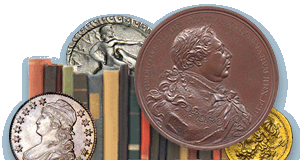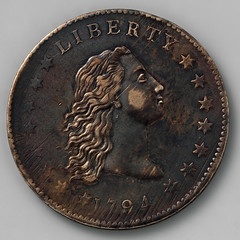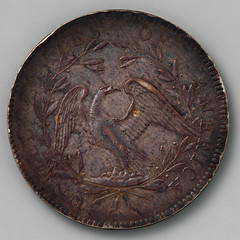
PREV ARTICLE
NEXT ARTICLE
FULL ISSUE
PREV FULL ISSUE
GARRETT'S NUMISMATIC DIARY: THE NETHERLANDSI recently took a post-graduation trip to the Netherlands. The following is a reflection on my numismatic encounters during the trip. -Garrett As my plane landed in the Netherlands, my first observation was how this country's flat land sharply contrasted with the steep hills of my adopted home of Pittsburgh. My destination was Den Bosch, a quintessential Dutch town of about 160,000 people. From here it was easy to catch a train to various locations within the country. I travelled to the Netherlands to do some biking as well as to learn more about Dutch history. Since history and numismatics go hand in hand, I planned to visit De Nieuwe Schatkamer (The New Treasure Room), located in De Nederlandsche Bank (DNB) headquarters in Amsterdam. DNB is the central bank of the Netherlands and also manages the Dutch National Numismatic Collection. It contains over 400,000 objects, approximately 400 of which are on display in this new exhibit. The National Numismatic Collection also includes a numismatic library with 50,000 titles and is open to the public by appointment. I contacted the library prior to my trip to schedule a visit, but they informed me it isn't currently accessible because it's being relocated. The news was disappointing, but it ultimately allowed me to spend more time in De Nieuwe Schatkamer. Visitors to this exhibit, which opened in March of this year, are first shepherded through a section that provides the history of the bank. The second section explores the statement that "Although the way the value of money is determined varies from place to place and changes over time, it's ultimately a matter of trust". A third section of the exhibit then connects this theme of trust to DNB. Against the backdrop of interactive displays on economics, it explores the ways in which DNB earns trust today, including inspecting and distributing money, monitoring financial institutions, and implementing monetary policy. A final numismatic experience allows visitors to view the bank's impressive vaults, which until 2020 contained part of the country's gold reserves. I appreciated the English translation of the text throughout the exhibit, although the interactive displays are only in Dutch. The exhibit covers many topics that are familiar to numismatists, such as Money and Trade; Money and War; and Counterfeit Money and nicely supports them with related objects. It's definitely worth a visit if you have a few hours to spare in Amsterdam. During my visit, there were many school groups being guided through the exhibit, so perhaps DNB will also play an important role in producing the next generation of Dutch numismatists! Another must-see destination in Amsterdam is the Rijksmuseum, the country's national museum. It houses the Cuypers Library, the largest and oldest historical art library in the Netherlands. In order to get the best view of this amazing library, you have to walk around a substantial case containing various numismatic specimens. It displays an impressive array of medals, chosen from the museum's collection of approximately 12,500 examples. They are arranged within select categories, including Guild, Rembrandt, Family, Historical, Honorary and Portrait. The display case also includes a wide variety of coins used in the Netherlands over many centuries as well as those from Dutch Colonies. A final section on Stivers, Guilders and Dollars is of particular interest to collectors of early United States coins, as it contains a 1794 Flowing Hair dollar. Unfortunately, I was unable to take a reasonable photo of the exposed obverse of the coin due to the reflective glass on the case. However, it can be seen along with the reverse image in these excellent photos provided by Henk Groenendijk. Thanks to the addition of the reverse image, numismatists can be sure that this coin is not a previously unknown die marriage of the 1794 dollar. Many Rijksmuseum visitors quickly take a picture of the Cuypers Library and then leave without viewing the medals and coins. This is unfortunate as they provide a great overview of Dutch history through numismatics. Several E-Sylum subscribers have visited this library over the years, including Patrick Ian Perez, whose 2022 article is linked below. Also linked below is an NNP article that provides information on the history of the Rijksmuseum numismatic collection. My visit to De Nieuwe Schatkamer and the Rijksmuseum were planned in advance, but I also had two unanticipated numismatic encounters. While wandering around the harbor city of Dordrecht, I came across this entranceway. I discovered that from 1367 to 1806, a mint in Dordrecht produced coins for the province of Holland. This street-facing arch dates to 1551. A walk through the alley and into a courtyard reveals the door to the mint, which is now a music store. I was also surprised to learn that my home base of Den Bosch has a small coin and stamp shop. Of course, I had visions of finding a rare U.S. coin or piece of paper money, so I eagerly entered the shop. It didn't turn out to be my day to hit the jackpot, but I did enjoy looking around and talking with the owner. His U.S. offerings consisted of a smattering of 20th century coins, the oldest of which were a 1912-D Barber half dollar and a 1921 Morgan dollar. He mentioned that the most widely collected U.S. coin denomination in the Netherlands is the dollar. However, he explained that European collectors need to be wary as it's fairly common to see counterfeits of very early U.S. dollars. This might explain how a genuine 1776 Continental dollar slipped through the cracks and was discovered in a junk box at a French flea market in 2018. It was fascinating to learn more about Dutch history through the lens of numismatics, but my visit was limited to a week. I had to travel back to Pittsburgh to attend a very important American numismatic event: the Early American Coppers Convention.
To read the earlier E-Sylum article, see:
Wayne Homren, Editor The Numismatic Bibliomania Society is a non-profit organization promoting numismatic literature. See our web site at coinbooks.org. To submit items for publication in The E-Sylum, write to the Editor at this address: whomren@gmail.com To subscribe go to: Subscribe All Rights Reserved. NBS Home Page Contact the NBS webmaster 
|







